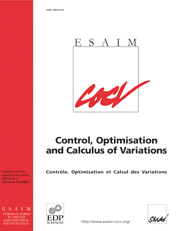Crossref Citations
This article has been cited by the following publications. This list is generated based on data provided by
Crossref.
Jimenez, Fernando
and
de Diego, David Martin
2010.
A geometric approach to discrete mechanics for optimal control theory.
p.
5426.
Ober‐Blöbaum, Sina
and
Walther, Andrea
2010.
Computation of derivatives for structure preserving optimal control using automatic differentiation.
PAMM,
Vol. 10,
Issue. 1,
p.
585.
Colombo, Leonardo
Martín De Diego, David
and
Zuccalli, Marcela
2010.
Optimal control of underactuated mechanical systems: A geometric approach.
Journal of Mathematical Physics,
Vol. 51,
Issue. 8,
Flaßkamp, Kathrin
Ober‐Blöbaum, Sina
and
Kobilarov, Marin
2010.
Solving optimal control problems by using inherent dynamical properties.
PAMM,
Vol. 10,
Issue. 1,
p.
577.
Flaßkamp, Kathrin
Ober-Blöbaum, Sina
and
Kobilarov, Marin
2012.
Solving Optimal Control Problems by Exploiting Inherent Dynamical Systems Structures.
Journal of Nonlinear Science,
Vol. 22,
Issue. 4,
p.
599.
Flaßkamp, Kathrin
Timmermann, Julia
Ober‐Blöbaum, Sina
Dellnitz, Michael
and
Trächtler, Ansgar
2012.
Optimal Control on Stable Manifolds for a Double Pendulum.
PAMM,
Vol. 12,
Issue. 1,
p.
723.
Moore, Ashley
Ober-Blöbaum, Sina
and
Marsden, Jerrold E.
2012.
Trajectory Design Combining Invariant Manifolds with Discrete Mechanics and Optimal Control.
Journal of Guidance, Control, and Dynamics,
Vol. 35,
Issue. 5,
p.
1507.
Ringkamp, Maik
Ober-Blöbaum, Sina
Dellnitz, Michael
and
Schütze, Oliver
2012.
Handling high-dimensional problems with multi-objective continuation methods via successive approximation of the tangent space.
Engineering Optimization,
Vol. 44,
Issue. 9,
p.
1117.
Flasskamp, Kathrin
Murphey, Todd
and
Ober-Blobaum, Sina
2012.
Switching time optimization in discretized hybrid dynamical systems.
p.
707.
Peng, Haijun
Gao, Qiang
Wu, Zhigang
and
Zhong, Wanxie
2012.
Symplectic Approaches for Solving Two-Point Boundary-Value Problems.
Journal of Guidance, Control, and Dynamics,
Vol. 35,
Issue. 2,
p.
653.
Kosmas, O.T.
and
Vlachos, D.S.
2012.
Local path fitting: A new approach to variational integrators.
Journal of Computational and Applied Mathematics,
Vol. 236,
Issue. 10,
p.
2632.
Ober-Blobaum, Sina
Ringkamp, Maik
and
zum Felde, Garlef
2012.
Solving multiobjective Optimal Control problems in space mission design using Discrete Mechanics and reference point techniques.
p.
5711.
Zhang, Jiawei
Zhang, Weizhong
and
Shan, Jiayuan
2012.
A new DMOC-based approach to solve Goddard rocket problem.
p.
2165.
Flaskamp, K.
and
Ober-Blobaum, S.
2012.
Energy efficient control for mechanical systems based on inherent dynamical structures.
p.
2609.
Bahadure, Sushant
Venkatesh, Chinde
Mehra, Rachit
Kazi, Farukh
and
Singh, Navdeep
2012.
Structure preserving optimal control of 2D-Spider Crane.
p.
1.
Schütze, Oliver
Witting, Katrin
Ober-Blöbaum, Sina
and
Dellnitz, Michael
2013.
EVOLVE- A Bridge between Probability, Set Oriented Numerics and Evolutionary Computation.
Vol. 447,
Issue. ,
p.
187.
Leyendecker, Sigrid
Pekarek, David
and
Marsden, Jerrold E.
2013.
Modeling, Simulation and Optimization of Bipedal Walking.
Vol. 18,
Issue. ,
p.
99.
Jiménez, Fernando
Kobilarov, Marin
and
Martín de Diego, David
2013.
Discrete Variational Optimal Control.
Journal of Nonlinear Science,
Vol. 23,
Issue. 3,
p.
393.
Fernández, Antonio
and
L. García, Pedro
2013.
Regular discretizations in optimal control theory.
Journal of Geometric Mechanics,
Vol. 5,
Issue. 4,
p.
415.
Ringkamp, Maik
Leyendecker, Sigrid
and
Ober‐Blöbaum, Sina
2013.
Multiobjective optimal control of a four‐body kinematic chain.
PAMM,
Vol. 13,
Issue. 1,
p.
27.


